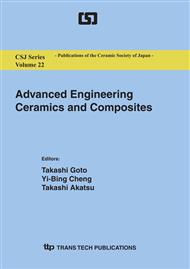p.65
p.70
p.75
p.82
p.89
p.98
p.102
p.107
p.117
Strengthening Mechanism of High-Strength Reaction-Sintered Silicon Carbide
Abstract:
A newly developed high-strength reaction-sintered silicon carbide (SiC), which has two or three times higher strength than conventional sintered SiC, is one of the most promising candidates for lightweight substrates of optical mirrors, because of its fully dense structure, small sintering shrinkage ( < 0.5 %), good shape capability, and low sintering temperature. In this paper, in order to improve the performance of the newly developed reaction-sintered SiC, the effect of the microstructure on the bending strength was investigated by focusing on a physical fracture model using observations from transmission electron microscopy and X-ray stress measurement. As a result, it was confirmed that the bending strength of the newly developed reaction-sintered SiC could be improved by reducing the size of residual silicon. The strengthening mechanism of the newly developed reaction-sintered SiC was assumed to be due to piled-up dislocations at the grain-boundary of residual silicon sites, based on Stroh’s fracture model of polycrystalline solids.
Info:
Periodical:
Pages:
89-97
Citation:
Online since:
July 2011
Authors:
Price:
Сopyright:
© 2011 Trans Tech Publications Ltd. All Rights Reserved
Share:
Citation:


